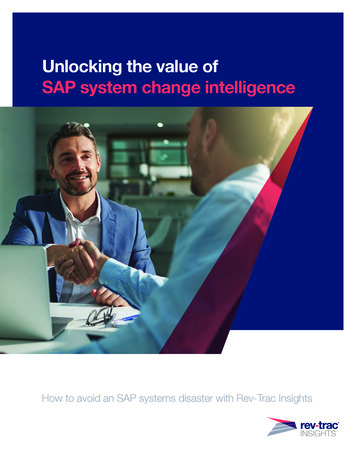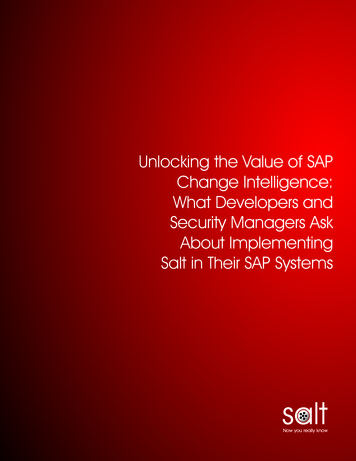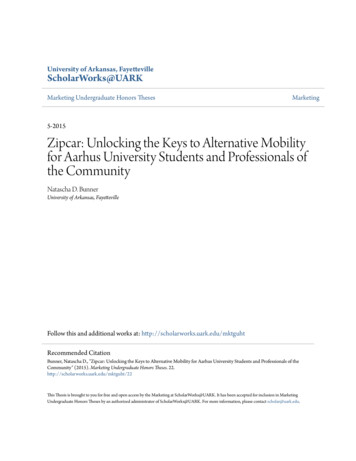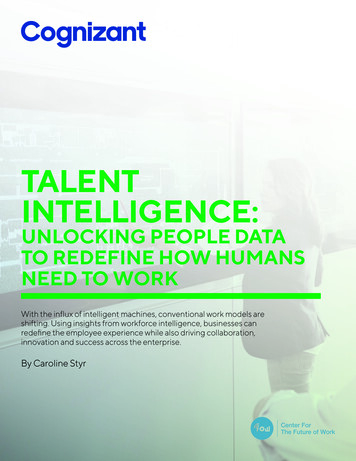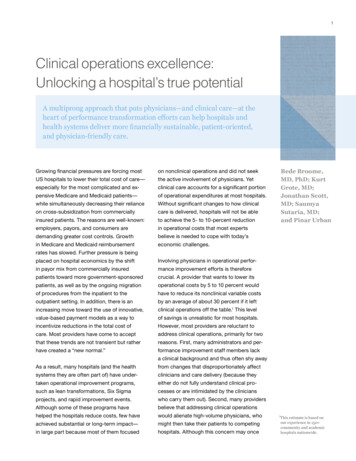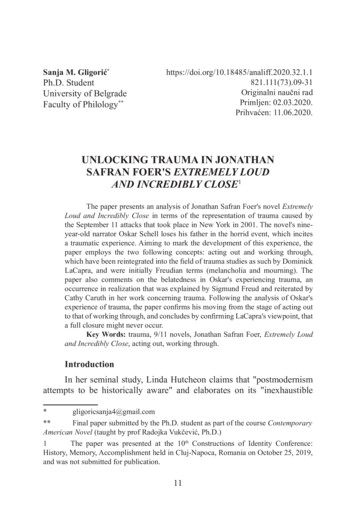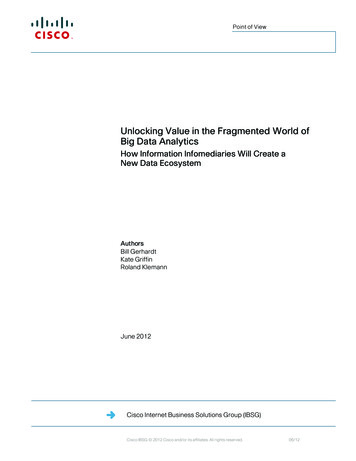
Transcription
Point of ViewUnlocking Value in the Fragmented World ofBig Data AnalyticsHow Information Infomediaries Will Create aNew Data EcosystemAuthorsBill GerhardtKate GriffinRoland KlemannJune 2012Cisco Internet Business Solutions Group (IBSG)Cisco IBSG 2012 Cisco and/or its affiliates. All rights reserved.06/12
Point of ViewUnlocking Value in the Fragmented World of Big Data AnalyticsHow Information Infomediaries Will Create a New Data EcosystemData Is “the New “Oil”As far back as 2006, market researcher Clive Humby declared data “the new oil.”1 Today, asdata transcends into the ever-expanding realm of Big Data, a growing community of expertsis beginning to agree. They see in Big Data the same transformative, wealth-creating powerthat 19th-century visionaries once sensed in the crude black ooze trapped underground.Just as oil once fired dreams a century or more ago, data is today driving a vision ofeconomic and technical innovation. If “crude” data can be extracted, refined, and piped towhere it can impact decisions in real time, its value will soar. When key insights can be minedfrom it through analytics—revealing complex behaviors, patterns, and events as theyhappen, if not before—then data will realize its inherent power. And if data can be properlyshared across an entire ecosystem and made accessible in the places where analytics aremost useful, then it will become a true game changer, altering the way we live, work, play,learn, buy, sell, travel—you name it.But with Big Data comes big challenges. The problem today is that the ever-increasingdeluge of information—terabytes to petabytes to exabytes—threatens to swamp us in agusher of unfiltered, unstructured, unprocessed, and seemingly unmanageable information.As things stand now, the data ecosystem is highly fragmented. Between those who createdata and those who could potentially extract value from it sits a labyrinth fraught withcomplexity, disparity, and miscommunication. If analytics are to be the new “refinery,” someof that fragmentation will need to be addressed with greater connectivity, trust, andefficiency.Who can and will take on this responsibility? The Cisco Internet Business Solutions Group(IBSG) believes that this overarching role will be filled by a new class of players: DataInfomediaries. These entities will step in and tie data originators to data beneficiaries,empowering the data originators and facilitating every step along the data-value chain. In theprocess, they will create opportunities for all players to harmonize, realize, and monetize thevast potential of Big Data.Crucial to this process will be the transport and storage infrastructures for Big Data. Playerswho can see far and wide—across networks and data centers, collecting and controllingdata in motion—will be in the best position to link disparate Big Data players into a smoothlyfunctioning whole.In this paper, we will examine some of the wider implications of Big Data, its transformativepromise, and some of the pain points that arise in trying to tame it. Above all, we will explorethe opportunities for Data Infomediaries to energize Big Data’s potential as a trulytransformative force, “the new oil” of our age.1http://ana.blogs.com/maestros/2006/11/data is the new.htmlCisco IBSG 2012 Cisco and/or its affiliates. All rights reserved.Page 2
Point of ViewThe True Nature of Big DataIn seeking better-informed decision making, many organizations are running datawarehouses and employing traditional data analytics—to reduce churn, bolster campaigneffectiveness, and counter fraud, to name a few applications. Big Data represents arevolutionary step forward from traditional data analysis, characterized by its three mainelements: variety, volume, and velocity. The variety of data comes in two flavors: structured and unstructured. Structured dataenters a data warehouse already tagged and is easily sorted. The vast majority oftoday’s data, however, is unstructured, and fed by sources such as Facebook, Twitter,and video content. It’s random, difficult to analyze, and enormous.The sheer volume of Big Data overwhelms the normal data warehouse. For example,Facebook reports that its users register 2.7 billion likes and comments per day. Formany, this magnitude of data is intimidating: they can’t keep up with it, much less sort it,analyze it, and extract value from it.All of that data can be challenging to manage when flooding in at a velocity that, formany players, far outpaces their processing ability. In order for Big Data to be a gamechanger, it needs to be analyzed at a rate that matches the blistering speed at whichinformation enters data warehouses. In microseconds, decisions must be made as towhether a particular bit of data deserves to be captured, and whether it has relevancewhen combined with other data. For example, the face of a known criminal amongthousands of images might trigger a “stop”; a pattern of credit fraud might set offwarnings; and indications of growing customer churn might inspire a coupon offer.Anytime there is an important anomaly in the data, it needs to be pointed out beforethe data is stored so that real-time action can be taken.Empowered by the NetworkBy its very nature, network traffic is Big Data. In just one slice of the network—the mobilenetwork—there are 6 billion mobile subscriptions in the world, and every day, 10 billion textmessages are sent.2 International Data Corp., the global market intelligence firm, estimatedthat in 2011, all of the data created in the world amounted to 1.6 trillion gigabytes.The amount of data crossing networks will continue to explode. By 2020, 50 billion deviceswill be connected to networks and the Internet.3 But the network is far from a “dumb pipe”simply transporting those reams of data. Beyond supporting the sheer volume, the networkcan play two valuable roles in increasing the Big Data’s potential for enterprises (see Figure1).First, the network can collect data and provide context at a high velocity. It can corral datafrom devices, private networks, and public wide-area networks, often in “network time.” Thisis the point where value is extracted and acted upon as events occur, in real or near realtime. With the data that the network collects, it can determine context. That context mightinclude matching location, identity, or presence information to the data. Moreover, actualcontent of the data that is collected can have value. Knowing not only which sites peoplebrowsed, but also what they did on those sites, can provide crucial insights.23International Telecommunication Union, 2012.“The Internet of Things: How the Next Evolution of the Internet Is Changing Everything,” Cisco IBSG, 2011.Cisco IBSG 2012 Cisco and/or its affiliates. All rights reserved.Page 3
Point of ViewFigure 1.The Network Connects Data Domains.Source: Cisco IBSG, 2012Second, the network makes it possible for enterprises to take immediate action on their datainsights. Through a series of control points in real time, the network can reach the customeror impact the customer’s experience. These control points exert changes in policy, privacy,preferences, security, quality of service, and rerouting or local processing.Having both the context and control aspect of the network in hand, those organizations withan end-to-end mastery of the network can see wide and deep.How Big Data Will Change Your LifeIf Big Data’s potential is fully realized, it will have a transformative impact across a broadspectrum of everyday tasks and activities, both complex and common (see Figure 2).Traffic jams are just one example. They may seem a necessary evil, here to stay. But imagineif they were vastly reduced or even eliminated. The savings in stress and time (which, ofcourse, equals money) would be enormous. Quality of life would increase, as commute timesare cut and family time increased. The answer is not flying cars but rather predictive, realtime analysis on traffic flows, feeding immediate changes to traffic signals, digital signs, androuting, before backups begin.What about those paper receipts from retailers and banks that are cluttering your wallet?Imagine if they were replaced by electronic records. Businesses could enrich these recordsthrough contextual and comparative information. Individuals could manage, share, monetize,and utilize the data through, for example, budget management and health adviceapplications.Cisco IBSG 2012 Cisco and/or its affiliates. All rights reserved.Page 4
Point of ViewFigure 2.Relevance of Big Data.Source: Cisco IBSG, 2012Medical advances enabled by Big Data could include treatments personalized to a patient’sunique health issues. Epidemics of contagious diseases or food contamination could bepredicted, tracked, and curtailed. Already, Google Flu Trends has aggregated data onsearches for health information to predict outbreaks across the globe.On a planetary scale (or beyond), Big Data can monitor and analyze vast amounts ofinformation on anything from climate change, astrophysics, and energy consumption togeopolitics and socioeconomics. In all cases, Big Data analysis can lead to a deeperunderstanding of key causes behind crucial events while anticipating future trends.Making Big Data Business-FriendlyBig Data can also change how we interact with businesses. Moment to moment, consumers’interactions with the world around them create an often-ignored by-product: massiveamounts of personal data. These include searches on weather, price comparisons,purchases, and thousands of other daily choices and actions. By analyzing the datagenerated by all of this activity, Big Data offers an opportunity to revolutionize the wayconsumers and sellers interact.Some businesses are already moving to take action. Here are a few examples:Cisco IBSG 2012 Cisco and/or its affiliates. All rights reserved.Page 5
Point of View Harrah’s enhanced revenues by 8 to 10 percent by analyzing customer segmentationdata,4 while Amazon at one time reported that its analytic recommendation enginedrove 30 percent of its revenues.5Wal-Mart’s inventory management implemented radio frequency identification (RFID)technology to connect real-time information between suppliers and its Retail Link datawarehouse. In the process, it reduced out-of-stocks by an estimated 16 percent. 6FedEx achieved real-time visibility with shipping and consumer data across more than46,000 distribution and supply chain locations.Kaiser Permanente reduced operating costs by 40 percent through integration of itselectronic medical records and its inpatient and outpatient management system.Integration of its clinical and cost data led to the discovery of Vioxx’s adverse effectsand subsequent withdrawal of the drug from the market.7Consequently, Big Data has already become top of mind among CIOs.8 Yet, Cisco IBSGenvisions an even higher level of data analysis and interaction along the data value chain.We have identified eight distinct classes of use cases derived from our analysis of a fewhundred potential applications of Big Data across many vertical industries:1. Revenue Assurance. Integrating intra-company data could hone identification andprevent fraud before it occurs. Fraud-intensive industries such as healthcare wouldparticularly benefit.2. Risk Mitigation. Every day, networks carry petabytes of critical information forenterprises, governments, and consumers, opening an ever-increasing risk ofintrusions and security attacks. Data federation across wider geographic and networkfootprints would enable identification of suspicious patterns while signaling the needfor immediate action.3. Customer Lifecycle. Businesses can zero in on instances of customer frustrationand offer an immediate response, thereby improving the consumer experience andlessening churn. Any service-based industry that values its customer relationshipswould benefit.4. Market Execution. Big Data enables better market services through analytics,creating improved opportunities for cross-selling and up-selling. Banking andInternet commerce stand out as potential beneficiaries.5. Product Innovation. Consumer input is critical in product development, and todaymany companies are already clamoring to know more about the likes and dislikes oftheir customers. Integrating noncompany sources of data such as social-networkfeeds would provide a more holistic view of how consumers feel about a product,potentially revealing the need for a new product before it is imagined or on thedrawing board.4Gartner, 2005.McKinsey & Company, 2011.6“Does RFID Reduce Out-of-Stocks?”, University of Arkansas, 2005; “Opening Up the Big Box: Measuring the WalMart Effect,” The Economist, February 23, 2006.7McKinsey & Company, 2011.8A 2011 IBM survey found that 83 percent of executives chose Big Data as their key topic over mobility solutions,virtualization, and cloud computing.5Cisco IBSG 2012 Cisco and/or its affiliates. All rights reserved.Page 6
Point of View6. Business Models. New pricing algorithms will create novel monetizationopportunities and more efficient interactions with consumers. Retailers in particularcould benefit from new pricing models tied to the location and behavior ofconsumers.7. Operations Management. Big Data could help almost any organization run betterand more efficiently. A service provider could improve the day-to-day operations ofits network. A retailer could create more efficient and lucrative point-of-saleinteractions. And virtually any supply chain would run more smoothly. Overall, acommon information fabric would improve process efficiency and provide acomplete asset view.8. Advanced Advertising. The more enterprises learn about customer behavior, theeasier it is to turn that information back into advertising. eMarketer has found that withadvanced, data-based targeting, the effectiveness of ads doubles. Cost-perthousand (CPM) lifts of more than 50 percent are possible. To further exploit theseadvantages through Big Data analy
from it through analytics—revealing complex behaviors, patterns, and events as they happen, if not before—then data will realize its inherent power. And if data can be properly shared across an entire ecosystem and made accessible in the places where analytics are
